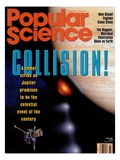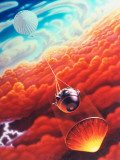Jupiter [♃], the fifth planet from the Sun, is the largest planet (two and a half times as massive as all of the other planets in our solar system combined) within the Solar System. Jupiter is classified as a gas giant along with Saturn, Uranus and Neptune.
Jupiter's best known feature is the Great Red Spot (GRS), a persistent anticyclonic storm that is larger than Earth. Both Robert Hooke and Giovanni Cassini described a “permanent spot”, respectively in 1664 and 1665; it is not known whether the spot dissapated, faded, or poor observational records are responsible for the spot not being confirmed again until 1830.
Comet Shoemaker–Levy 9 broke apart and collided with Jupiter in July 1994, providing the first direct observation of an extraterrestrial collision of Solar System objects.
~~~~~~~~~~~~~~~~~~~~~~~~~~~~~
Facts About Jupiter
• Distance from the sun: 483.8 million miles
• Diameter: 88,846 miles
• Length of year: About 12 Earth years
• Rotation period/lenth of “day”: 9 hours, 56 minutes
• Temperature: Minus 230º to plus 70º Fahrenheit
• Atmosphere: Hydrogen, helium, and small amounts of other gases
• Number of moons: at least 66














